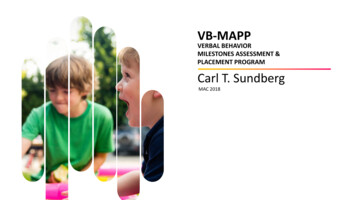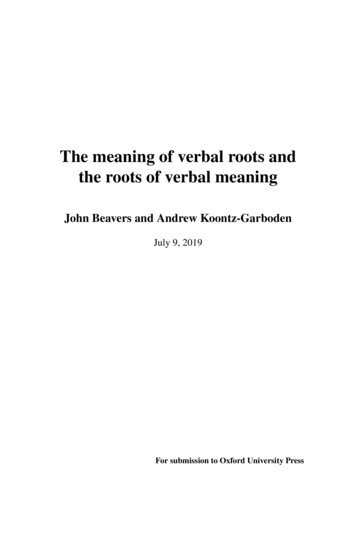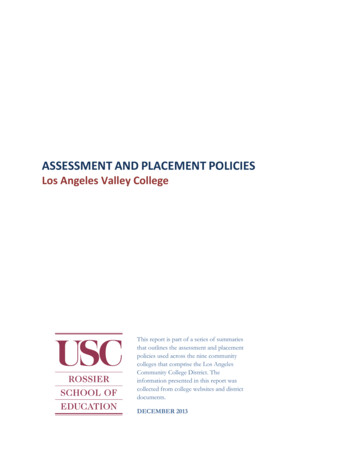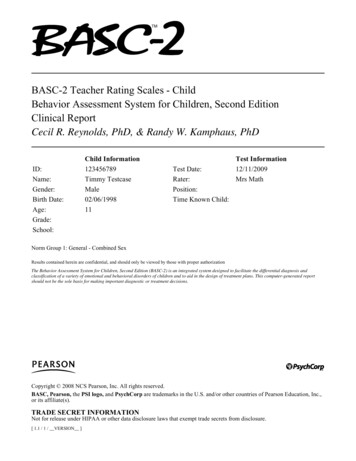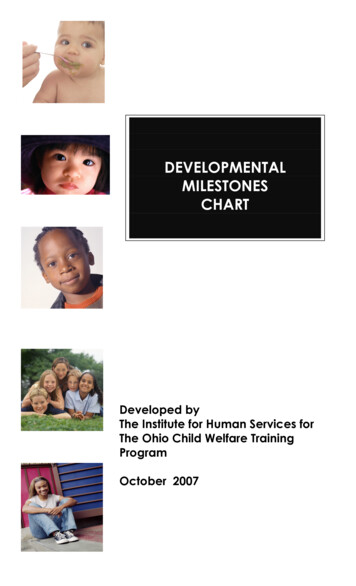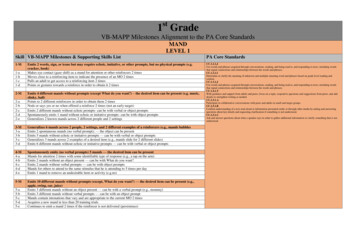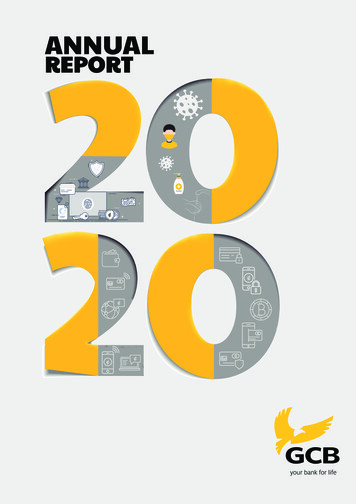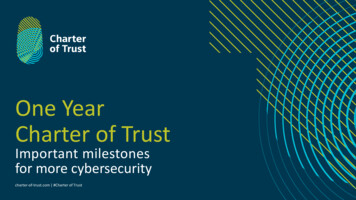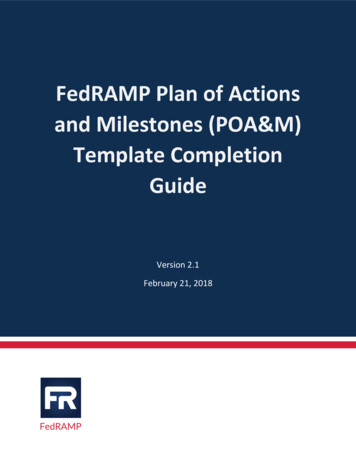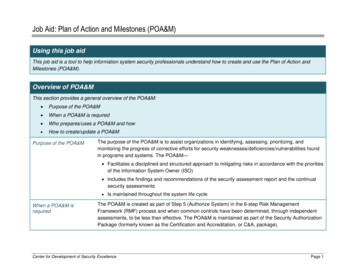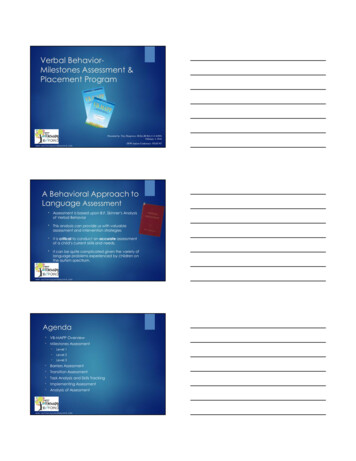
Transcription
2/3/2016Verbal BehaviorMilestones Assessment &Placement ProgramPresented by: Trey Hargroves, M.Ed.,BCBA (1-11-8499)February 4, 2016www.mytherapyandbeyond.comDFW Autism Conference- FEAT-NTA Behavioral Approach toLanguage AssessmentAssessment is based upon B.F. Skinner’s Analysisof Verbal BehaviorThis analysis can provide us with valuableassessment and intervention strategiesIt is critical to conduct an accurate assessmentof a child’s current skills and needs.It can be quite complicated given the variety oflanguage problems experienced by children onthe autism spectrum.www.mytherapyandbeyond.comAgendaVB-MAPP OverviewMilestones AssessmentLevel 1Level 2Level 3Barriers AssessmentTransition AssessmentTask Analysis and Skills TrackingImplementing AssessmentAnalysis of Assessmentwww.mytherapyandbeyond.com1
2/3/2016The Purpose of a LanguageAssessmentDetermine operant level of a child’s verbal (and related)skillsCompare to “neuro-typical” language developmentdataIdentify language acquisition & learning barriersIdentify if and where to begin interventionEstablish Treatment Plan goalsDesign an individualized intervention programDetermine best teaching strategiesMonitor if the intervention is effectivewww.mytherapyandbeyond.comVerbal Operants Assessed onthe VB-MAPPMandTactListenerEchoicImitationCopying a dbeyond.comVerbal OperantsSkinner (1957) calls this collection of language skills “TheElementary Verbal Operants”The elementary verbal operants are separate repertoiresand functionally independent at the time of acquisition,and each must be taughtSpeaker and listener skills are separate repertoires andeach must be taughtMore complex language, such as conversations andlanguage related to social skills, is comprised of thesebasic elementswww.mytherapyandbeyond.com2
2/3/2016Validity of our Assessmentswww.mytherapyandbeyond.comVB-MAPP OverviewFive components of the VB-MAPP:Milestones Assessment contains 170 verbal behavior milestonesacross 3 developmental levels (0-18 mos., 18-30 mos., 30-48 mos.), and 16different verbal operants and related skillsBarriers Assessment examines 24 common learning andlanguage barriers faced by children with autism and language delaysTransition Assessment contains 18 measurable areas to providean objective evaluation of a student’s skills and learning capabilities toidentify the setting that they may best learn inTask Analysis and Skills Tracking provides a furtherbreakdown of the 16 different skill areas in the form of a checklist for skillstrackingCurriculum Placement & IEP Goals directly linked to theassessments above and provides specific direction for each of the 170milestones and helps design a balanced intervention programwww.mytherapyandbeyond.comDevelopmentThe VB-MAPP spans a 30 history of research anddevelopment by Mark SundbergIn 1998 together with James Partington Dr. Sundberg createdThe Assessment of Basic Language and Learning Skills (ABLLS)which:‘Lacked developmental appropriate scope andsequence’‘Never meant to be utilized as curriculum’‘Provides no guidance for what order to targetobjectives’www.mytherapyandbeyond.com3
2/3/2016Methods of Measurement For educational purposes the goal is to as efficiently andeffectively as possible setsdevelopmentally appropriategoals and objectives. Information on a specific studentcan be gathered in a variety of waysIncludes:Interviews with parents, teachers, or service providerObservation of the student in natural settingSpecific assessment of the skill (especially true for ent Methods Usedto Assess MilestonesFormal Testing (T): Specifically presenting the child with atask and recording the responseObservation (O): Watching for the skill to occur inenvironmental settings without formal presentationEither Formal Testing or Observation (E): assessor candetermine which of above to useTimed Observation (TO): Target response must occurwithin a fixed amount of timewww.mytherapyandbeyond.comMilestones AssessmentThe Milestones Assessment is:Developmentally appropriate in scope and sequenceCriterion referenced assessmentBroken into 3 developmental levelsLevel 1; 0-18 monthsLevel 2; 18-30 monthsLevel 3; 30-48 monthsThe scores for each skill are balanced across each levelThere are 5 items and 5 possible points for each skill areawww.mytherapyandbeyond.com4
2/3/2016Milestones Level 10-18 monthsInstructions for scoring begin on page 27 of the GuidebookThe task for the person performing the assessment isto identify a baseline for each skillIf a test item is clearly a part of the child’s skillset,score that as a 1 and move onIf the child is reaching a level of acquisition, but maynot completely demonstrate a skill, more directtesting is warrantedwww.mytherapyandbeyond.comLevel 1 Skill AreasMandTactListenerVisual Perceptual ytherapyandbeyond.comwww.mytherapyandbeyond.com5
2/3/2016Milestones Level 218-30 monthsInstructions for scoring begin on page 47 of the GuidebookIn Level 2 new skill sets are representedThese areas were not present in Level 1 becausemost typically developing 18 month children haveyet to acquire themIt is hoped by presenting these in Level 2 it will beclearer what to focus on for a child scoring in eachof the levelswww.mytherapyandbeyond.comLevel 2 Skill AreasAll skill areas from Level 1 except Vocal with the additionof:Listener Responding by Feature, Function & Class(LRFFC)Intraverbal (IV)Classroom SkillsGroup SkillsLinguistic dbeyond.com6
2/3/2016Milestones Level 330-48 monthsThe instructions for scoring begin on page 71 of theGuide bookAs in Level 2, in Level 3 there are new skill setsrepresentedThese academic skills should be avoided as part ofthe curriculum with language delays that fall primarilyin Level 1 or 2www.mytherapyandbeyond.comLevel 3 Skill AreasAll skill areas from Level 2 except Imitation & Echoics, withthe addition .mytherapyandbeyond.com7
2/3/2016Barriers AssessmentTool designed to identify and score 24 different learning andlanguage acquisition barriersOnce a specific barrier has been identified, a more detaileddescriptive and/or functional analysis of that problem isrequiredThere are many ways that a verbal repertoire or related skillcan become defectiveIndividualized analysis are necessary to determine thenature of the problem, and what intervention programmight be andbeyond.comBarriers Assessment Common Learning and Language Acquisition Barriers:Instructional control (Escape/avoidance)Behavior problemsDefective mand, tact, intraverbal, motor imitation,listener discriminationDefective echoicPrompt DependentScrolling ResponsesWeak or atypical motivationwww.mytherapyandbeyond.com8
2/3/2016Where did these BarriersOriginate? Their Environment. i.e., If a child cannot effectively mand: Other behavior will begin to serve as the mand function Extinction sets in and reinforcers narrow The child starts to need adults less and less to get needsmetDr. Sundberg argues that WE helped create 23 out of24 Barriers!www.mytherapyandbeyond.comTransition AssessmentCan provide a measurable way for a child’s IEP team tomake decisions and set priorities in order to meet the child’seducational needsComprised of several summary measures from other parts ofthe VB-MAPP, as well as a variety of other skills that canaffect transition including:Overall score on theMilestonesOverall score on BarriersNegative behaviorsClassroom routines andgroup skillsSocial skillsAcademic independenceGeneralizationVariation of reinforcersRate of skill acquisitionRetentionNatural environment learningTransfer skillsAdaptability to changeSpontaneityIndependent playGeneral self-helpToileting skillsEating yond.com9
2/3/2016Task Analysis & Skills TrackingProvides a further breakdown of skills, and serves as a morecomplete and ongoing learning and language skills curriculumguideThere are approximately 900 skills presented covering the 16 areasof the VB-MAPPOnce the Milestones have been assessed and the general skilllevel has been established, the task analysis can provide furtherinformation about a particular childThe skills identified on the task analysis contain a wide range ofsupporting components of the target area.These skills may not be significant enough to identify as Milestonesor IEP goals, but each of them play an important role in moving achild’s repertoire closer to that of a typically developing yond.comTask Analysis & Skills Trackingwww.mytherapyandbeyond.com10
2/3/2016Task Analysis& SkillsTrackingwww.mytherapyandbeyond.comBefore You BeginUSE YOUR GUIDEBOOK!!Turn to page 19 of the Guide book, review table 2-1 to seetips for the testerMake sure you have material to test each skill (should begathered in the VB-MAPP tubs in the office)ALWAYS have a copy of the Guide Book with you duringassessmentDO NOT assume that if they can demonstrate half of the skillthat would give them a score of 1, that you can give them a½ pointwww.mytherapyandbeyond.comInterpreting VB-MAPP ResultsStep 1Identify general level of the childLevel 1, 2, or 3Each level is designed to correspond with anapproximate linguistic and developmental ageCertain skills, targets, & teaching styles may be moreeffectivewww.mytherapyandbeyond.com11
2/3/2016Interpreting VB-MAPP ResultsStep 2Look at the scores in each skill area and theirrelation to the student’s performance in other areasAre there strengths in one area that could benefit thestudent?Weaknesses that need to be addressed?I.e., if a student has a strong receptive repertoire but weakechoic, you may want to look at PECSwww.mytherapyandbeyond.comInterpreting VB-MAPP ResultsStep 3Look for balance across all of the skill areas (mand,tact, listener,etc.)The Milestones Assessment is designed to be able toquickly read a profile by looking for a generalbalance of one repertoire in relation to anotherA student is out of balance if they have 100 listenerskills but only a few mands-Focus would need to beon mandingwww.mytherapyandbeyond.comScores Within Level 1 Focus should be on establishing:MandsEchoicsMotor ImitationListener DiscriminationsTactsVisual Perceptual & Matching Skillswww.mytherapyandbeyond.com12
2/3/2016www.mytherapyandbeyond.comLevel 1 LearnersPlay and social skills should be a major part ofinterventionTeaching style may be more ‘intensive’Higher number of trialsCarefully arranged contingenciesPromptingPrompt FadingShapingTransfer of Stimulus ControlUse of MotivationDifferential Reinforcementwww.mytherapyandbeyond.comSample IEP Goals-Level 1Learner‘ Johnny will , with 90% accuracy across 3 consecutivedays.’Emit 10 different mands with/without desired item presentSpontaneously emit (without prompt- “what do you want”)average of 50 or more mands per dayTact 50 itemsTact 10 actionsID 50 items in messy array of at least 8Perform 20 specific actions on commandMatch 100 non-identical objects or pictures in array of 10Imitate 25 two-component actionsEcho 50 V-C combinations of 2 syllables or more or full wordsMand to peers 5 times per day**Seepage 150 of VB-MAPP Guidewww.mytherapyandbeyond.com13
2/3/2016Scores Within Level 2Still an early learner, but is beginning to show solidlearning and language skillsFocus should be on systematically expanding existingskills in a variety of nd.comLevel 2 LearnersGeneral target areas forming core ofintervention should be:Expand the scope and size of mand, tact, andlistener repertoires (teach more nouns, verbs,adjectives)Develop two- and three-step motor imitation andinstruction followingBeginning LRFFCBeginning intraverbal skillsDevelop social and verbal interactions with peersDevelop group and classroom skillsLearning in less restrictive settingswww.mytherapyandbeyond.com14
2/3/2016Sample IEP Goals-Level 2Learner‘ Johnny will , with 90% accuracy across 3 consecutivedays.’Mand for 50 different missing item with only verbal prompt (“whatdo you need?”)Spontaneously mand for other people to perform 10 specificactions in natural environment(game, play)Tact and LD 250 itemsTact and LD 25 actionsID 10 different colors or shapes in array of 5Match 200 non-identical objects or pictures in array of 10,containing 3 similar itemsSelect correct item from messy array of 10 given 200 different fill-insor WH questions for FFCAnswer 200 fill-in and WH questions involving noun and verb(intraverbal)Respond to mands from peers 10 times per day**Seepage 173 of VB-MAPP Guidewww.mytherapyandbeyond.comScores Within Level 3A student who is reaching the milestones in Level 3 isdemonstrating a solid foundation of skills that will allowfor more advanced language, social, and academicinstructionLevel 3 begins at the developmental equivalent of 30months of age when children have acquired TONS oflanguageHundreds of mands, tacts and listener responsesEasily learning new words on a daily basisMands are spontaneous, frequent, and controlled bychild’s personal motivators-especially those thatrelate to verbal information (asking ndbeyond.com15
2/3/2016Level 3 LearnersGeneral target areas forming core ofintervention should be:Expand the content of what the child talks about by teachingnew mands, tacts, and LD responsesExpand sentence size by teaching child to modify basic nounsand verbs with adjectives, prepositions, pronouns, adverbs.Develop more complex mands- such as mands for information& involving parts of speechTeach intraverbal behavior (how to talk about things notpresent)Learn to use verbal skills in socially appropriate waysDevelop social and verbal interactions with peersIncrease fre
VB-MAPP Overview Five components of the VB-MAPP: Milestones Assessment contains 170 verbal behavior milestones across 3 developmental levels (0-18 mos., 18-30 mos., 30-48 mos.), and 16 different verbal operants and related skills Barriers Assessment examines 24 common learning and language barriers faced by children with autism and language delays
